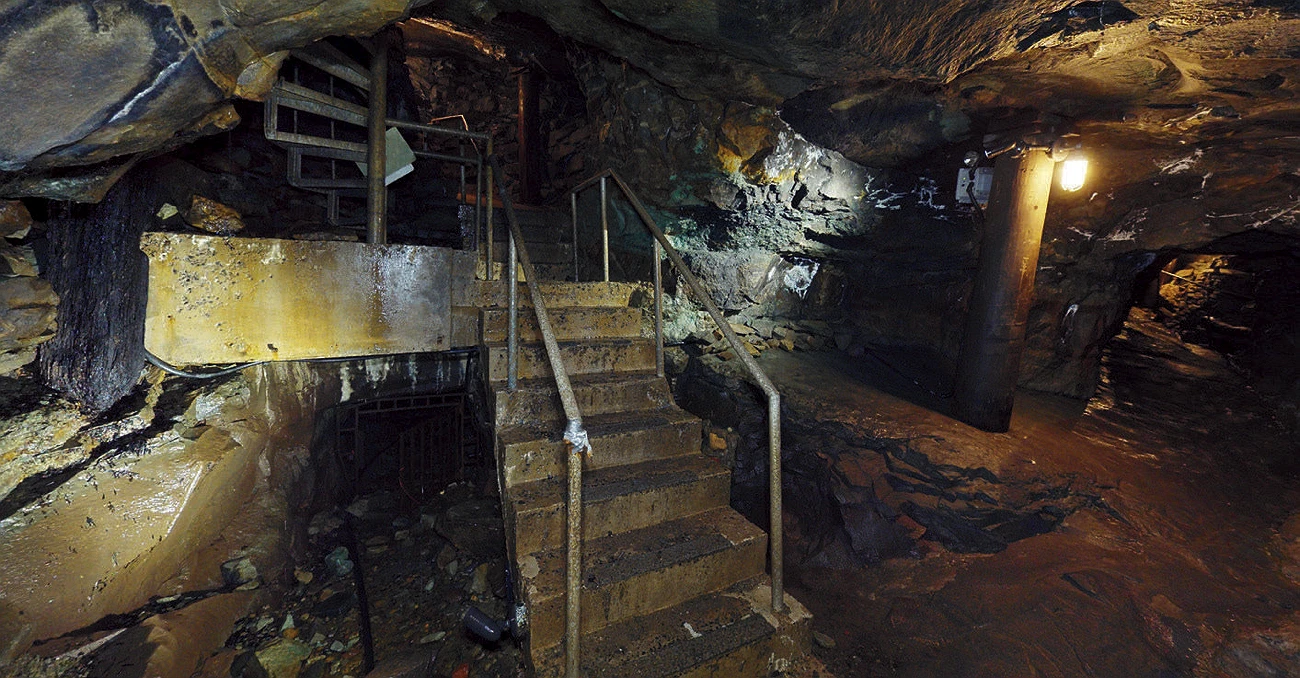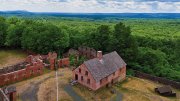Descending 75 feet into a dark, wet stone cavern that had once been a copper mine, tour guide Bob Ravens-Seger points out a 40-square-foot section of dank rock. “This is where the prisoners lived,” he says—up to 60 men, crowded together, shackled to their bunks. “There was no light, no supervision, no sanitary facilities, and no segregation of prisoners,” Ravens-Seger adds. “It was complete bedlam for the 12 hours they were down here left to their own devices.”
When allowed aboveground, the prisoners ate scrappy meals and labored. Officials soon learned it was unwise to hand out mining picks. So, instead, prisoners made nails and later shoes, wagons, and baskets. Twenty-two at a time, they walked the Treadmill, a group StairMaster-like device that ground grain.
Still, when it opened in 1773, New-Gate’s approach to punishment was considered relatively enlightened. Before that, county lockups existed (e.g., for problem drunkards), but violent public abuse and humiliation prevailed. Pillories and stocks. Ear croppings. Brandings. New-Gate’s founding officials “were trying to reform,” says Morgan Bengel, a curator and site administrator at the state-owned Old New-Gate Prison and Copper Mine museum, in East Granby, Connecticut. “They thought they could put prisoners to work and that it would be sufficient security and housing.”

The earliest prisoners were serving time for crimes like horse-stealing, burglary, and counterfeiting. Such wrongdoers as Daniel Collyer Humphry and William Johnson Crawford arrived in 1774, and remain buried under the rock avalanche they caused by trying to dig their way to freedom. With the American Revolution came political prisoners, including Tories, along with court-martialed Continental Army soldiers. New-Gate’s population swelled. “This was a school for crime,” Ravens-Seger says. “You came here as a 14-year-old as a snatch-and-grab and you came out six months later as a monster.” Some acted up just to be put in solitary confinement—a blasted-out stone corner that flooded, creating a septic-tank atmosphere. It was challenging, Ravens-Seger says, yet also gave guys the chance “to sit on their keisters 24/7 while the others worked 72-hour weeks.”
After the war, New-Gate took on more hardened criminals, yet no murderers, save for Thirza Mansfield, who was sentenced to life in 1825 for axing her abusive, alcoholic husband. By then, the state had erected a new four-story aboveground prison next to the copper mine, which had cell block dormitories. The underground population had been moved there, but a core group chose to remain, citing camaraderie and lack of supervision.
Meanwhile, New-Gate’s deservedly sinister reputation had made it a target of criminal justice reformers. That pressure, combined with a failing economic model and poor infrastructure, led New-Gate to close in 1827. The prisoners were marched to the new Wethersfield State Prison (since razed), where they could learn trades, breathe fresh air, exercise, and receive religious teachings. (Around that same time, new prisons with rehabilitative-related modalities, Eastern State Penitentiary and Sing Sing Correctional Facility, also opened in Philadelphia and Ossining, New York.) Private mining operations soon resumed, but by the 1920s the guardhouse was a dance hall, and in the 1950s, caged monkeys, a bear, and a World War I tank drew crowds to the site.“It had a P.T. Barnum curiosity,” Bengel says, “Like, ‘Bring your girl, have a chicken dinner across the street, and see the dungeon.’”
That ended in 1968 when the state bought the property to turn it into a museum. Repairs and restorations have ensued. Visitors now get a fascinating tour of the caverns and can explore the ruins of the nineteenth-century brick buildings, the restored guardhouse, and grounds—with texts and historic images that explain the site’s incarnations. “New-Gate was an experiment,” Bengel says. “The criminal justice system has always evolved through push-and-pulls and power struggles. New-Gate is one of the only opportunities where we, the general public, can be in a prison and continue to critically think about how the system should operate.”








